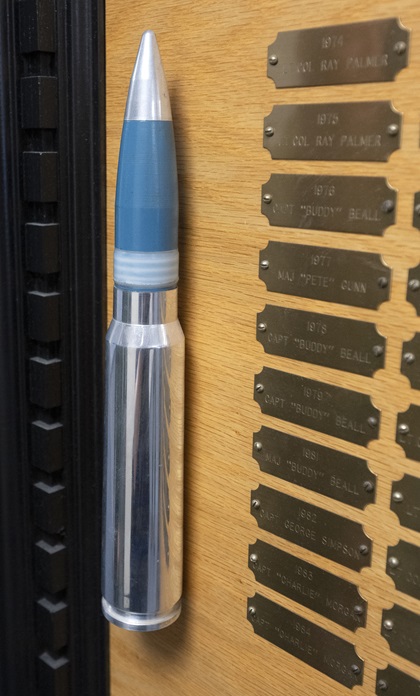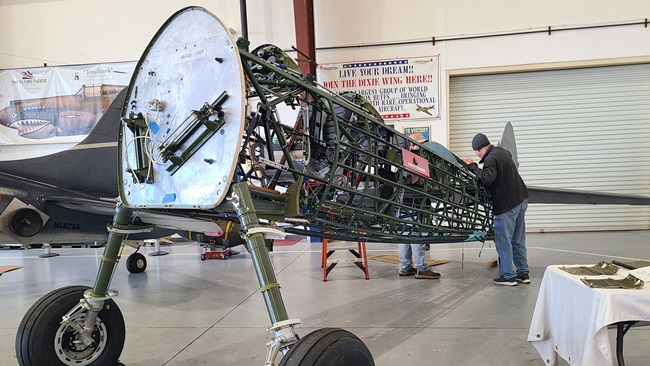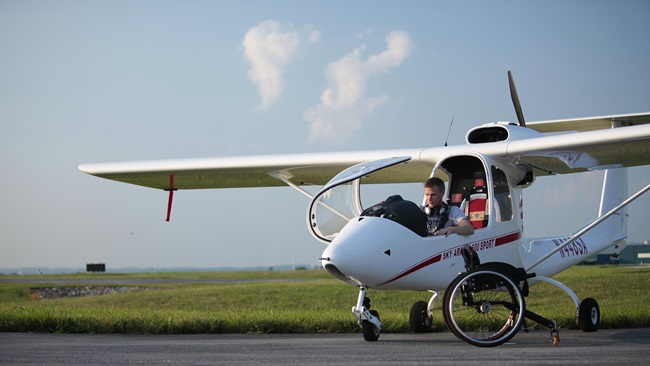Behind-the-scenes look at the ‘Warthog’
Join us for closeups of the Fairchild Republic A–10C Thunderbolt II close air support jet
A ground-to-air encounter with Maryland Air National Guard crews flying the fabled and feared Fairchild Republic A–10C led to an up-close-and-personal look at the armament-carrying Thunderbolt II close air support and ground-attack jet affectionately known as the “Warthog” and a chance to fly one—in a simulator.
Lt. Col. Chris “Slug” Palmer, who participated in an A–10C formation flyover of Maryland to salute coronavirus frontline personnel on May 8, invited AOPA for a visit to Martin State Airport near Baltimore to get to know the flying cannon that the U.S. Air Force calls the “first aircraft specially designed for close air support of ground forces.”
Palmer and Capt. Nick “Rock” Sand are airline pilots and 175th Wing colleagues. They both complimented the twin-engine, twin-rudder jet for its excellent maneuverability at high and low speeds, its range, and its impressive weaponry.
A night vision system allows pilots to spot targets from afar under the cover of darkness, and a bubble canopy provides 360-degree views in the daylight. Titanium armor protects pilots and control systems from ground fire. Armament includes one 30mm GAU-8/A seven-barrel Gatling gun on the aircraft’s nose and up to 16,000 pounds of mixed ordnance. Weaponry is carried on eight under-wing and three under-fuselage pylons and includes AGM-65 Maverick missiles, AIM-9 Sidewinder missiles, laser-guided/electro-optically guided bombs, and numerous countermeasures.
 The robust “Warthog” is nicknamed for its aggressive look, and examples of the jet often include a snarling set of teeth painted on its nose. The U.S. Air Force says it can “survive direct hits from armor-piercing and high explosive projectiles up to 23mm. [Its] self-sealing fuel cells are protected by internal and external foam. Manual systems back up [its] redundant hydraulic flight-control systems so pilots can still limp home to land if hydraulic power is lost. Many of the aircraft’s components are interchangeable from the left and right sides.
The robust “Warthog” is nicknamed for its aggressive look, and examples of the jet often include a snarling set of teeth painted on its nose. The U.S. Air Force says it can “survive direct hits from armor-piercing and high explosive projectiles up to 23mm. [Its] self-sealing fuel cells are protected by internal and external foam. Manual systems back up [its] redundant hydraulic flight-control systems so pilots can still limp home to land if hydraulic power is lost. Many of the aircraft’s components are interchangeable from the left and right sides.
AOPA Manager of Aviation Events Erick Webb and I tried our hands at flying the “Warthog” in a simulator outfitted with a dizzying array of advanced weaponry and systems (sorry, no photos allowed). The high-energy, aerobatic experience far surpassed our sedate flights from Frederick in a couple of Cessnas.
Palmer and Sand promised the Thunderbolt II would be easy to fly, and they were right. We quickly grew accustomed to manipulating the dual thrust levers and a control stick that contained push-button weapon triggers in addition to familiar push-to-talk communication and trim buttons.
Yank, bank, and fire were the orders of the day as we encountered battleships mysteriously positioned just off the coast of Maryland and dodged other aircraft shooting at us. The Thunderbolt II responded quickly to stick inputs. Liberal use of the trim switch eased pitch forces, but my right arm was getting a good workout anyway. The jet was just as at home upside down and slamming into numerous high-G banks at 250 knots as it was on final to Runway 15 at a relatively sedate 150 kts. The sky around me lit up in red as I touched down close enough to the centerline to apply liberal braking without swerving while under attack by another Air National Guard pilot practicing his shooting skills. I eased myself out of the cockpit in a full sweat despite the air-conditioned flight simulator environment. Webb and I saluted the pilots who routinely practice to maintain our country’s defense and thanked them for the unique opportunity to fly the feared “Warthog.”
The first Thunderbolt II was delivered in 1975 and the upgraded A–10C version was made operational in 2007. The aircraft’s survivability has been proved in numerous enemy encounters, including during operations Desert Storm, Noble Anvil, and Enduring Freedom, among others. The Air Force describes the flying weapons as “simple, effective and survivable twin-engine jet aircraft that can be used against all ground targets, including tanks and other armored vehicles.”
Palmer said Maryland Air National Guard crews can train “down to 100 feet” during “surface attack sorties” that mimic the battlefield arena. However, for safety purposes the aircraft are outfitted with simulated munitions and “everything is done electronically” during training runs in military operating areas near the Chesapeake Bay and Patuxent River.













































